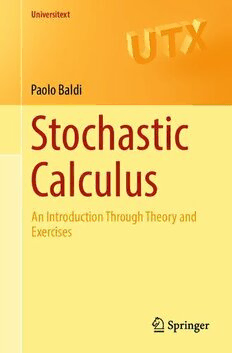Table Of ContentUniversitext
Paolo Baldi
Stochastic
Calculus
An Introduction Through Theory and
Exercises
Universitext
Universitext
Serieseditors
SheldonAxler
SanFranciscoStateUniversity
CarlesCasacuberta
UniversitatdeBarcelona
AngusMacIntyre
QueenMary,UniversityofLondon
KennethRibet
UniversityofCalifornia,Berkeley
ClaudeSabbah
Écolepolytechnique,CNRS,UniversitéParis-Saclay,Palaiseau
EndreSüli
UniversityofOxford
WojborA.Woyczyn´ski
CaseWesternReserveUniversity
Universitext is a series of textbooksthat presents material from a wide variety of
mathematicaldisciplinesatmaster’slevelandbeyond.Thebooks,oftenwellclass-
testedbytheirauthor,mayhaveaninformal,personalevenexperimentalapproach
to their subject matter. Some of the most successful and established books in the
series have evolved through several editions, always following the evolution of
teachingcurricula,toverypolishedtexts.
Thus as research topics trickle down into graduate-level teaching, first textbooks
writtenfornew,cutting-edgecoursesmaymaketheirwayintoUniversitext.
Moreinformationaboutthisseriesathttp://www.springer.com/series/223
Paolo Baldi
Stochastic Calculus
An Introduction Through Theory
and Exercises
123
PaoloBaldi
DipartimentodiMatematica
UniversitaJdiRoma“TorVergata”
Roma,Italy
ISSN0172-5939 ISSN2191-6675 (electronic)
Universitext
ISBN978-3-319-62225-5 ISBN978-3-319-62226-2 (eBook)
DOI10.1007/978-3-319-62226-2
LibraryofCongressControlNumber:2017948389
MathematicsSubjectClassification(2010):60H10,60H05,60H30,60G42,60G44
©SpringerInternationalPublishingAG2017
Thisworkissubjecttocopyright.AllrightsarereservedbythePublisher,whetherthewholeorpartof
thematerialisconcerned,specificallytherightsoftranslation,reprinting,reuseofillustrations,recitation,
broadcasting,reproductiononmicrofilmsorinanyotherphysicalway,andtransmissionorinformation
storageandretrieval,electronicadaptation,computersoftware,orbysimilarordissimilarmethodology
nowknownorhereafterdeveloped.
Theuseofgeneraldescriptivenames,registerednames,trademarks,servicemarks,etc.inthispublication
doesnotimply,evenintheabsenceofaspecificstatement,thatsuchnamesareexemptfromtherelevant
protectivelawsandregulationsandthereforefreeforgeneraluse.
Thepublisher,theauthorsandtheeditorsaresafetoassumethattheadviceandinformationinthisbook
arebelievedtobetrueandaccurateatthedateofpublication.Neitherthepublishernortheauthorsor
theeditorsgiveawarranty,expressorimplied,withrespecttothematerialcontainedhereinorforany
errorsoromissionsthatmayhavebeenmade.Thepublisherremainsneutralwithregardtojurisdictional
claimsinpublishedmapsandinstitutionalaffiliations.
Printedonacid-freepaper
ThisSpringerimprintispublishedbySpringerNature
TheregisteredcompanyisSpringerInternationalPublishingAG
Theregisteredcompanyaddressis:Gewerbestrasse11,6330Cham,Switzerland
To thememoryof GianniDi Masi
Preface
Courses in Stochastic Calculus have in the last two decades changed their target
audience. Once this advanced part of mathematics was of interest mainly to
postgraduates intending to pursue an academic research career, but now many
professionalscannotdowithouttheabilitytomanipulatestochasticmodels.
Theaim ofthisbookisto providea toolinthisdirection,startingfroma basic
probability background (with measure theory, however). The intended audience
should,moreover,haveseriousmathematicalbases.
Theentirecontentofthisbookshouldprovidematerialforatwo-semesterclass.
MyexperienceisthatChaps.2–9providethematerialforacourseof72h,including
thetimedevotedtotheexercises.
To be able to manipulate these notionsrequiresthe reader to acquire not only the
elementsofthetheorybutalsotheabilitytoworkwiththemandtounderstandtheir
applicationsandtheirconnectionswithotherbranchesofmathematics.
Thefirstoftheseobjectivesistakencareof(oratleastIhavetriedto...)bythe
developmentofalargesetofexerciseswhichareprovidedtogetherwithextensive
solutions.Exercisesarehardwiredwiththetheoryandareintendedtoacquaintthe
reader with the full meaning of the theoretical results. This set of exercises with
theirsolutionispossiblythemostoriginalpartofthiswork.
Asfortheapplications,thisbookdevelopstwokinds.
The first is given by modeling applications. Actually there are very many
situations(infinance,telecommunications,control,...)wherestochasticprocesses,
andin particulardiffusions,are a naturalmodel.In Chap.13 we developfinancial
applications,currentlyarapidlygrowingarea.
Stochastic processes are also connected with other fields in pure mathematics
and in particular with PDEs. Knowledge of diffusion processes contributes to a
betterunderstandingofsomeaspectsofPDEproblemsand,conversely,thesolution
of PDE problems can lead to the computation of quantities of interest related to
diffusionprocesses.Thistwo-waytightconnectionbetweenprocessesandPDEsis
developedinChap.10.Furtherinterestingconnectionsbetweendiffusionprocesses
vii
viii Preface
andotherbranchesofmathematics(algebraicstructures,differentialgeometry,...)
areunfortunatelynotpresentinthistext,primarilyforreasonsofspace.
Thefirstgoalistomakethereaderfamiliarwiththebasicelementsofstochastic
processes,suchasBrownianmotion,martingales,andMarkovprocesses,sothatit
isnotsurprisingthatstochasticcalculusproperbeginsalmostin themiddleofthe
book.
Chapters2–3introducestochasticprocesses.Afterthedescriptionofthegeneral
setting of a continuous time stochastic process that is given in Chap.2, Chap.3
introduces the prototype of diffusion processes, that is Brownian motion, and
investigatesits,sometimessurprising,properties.
Chapters 4 and 5 providethe main elements on conditioning,martingales, and
their applications in the investigation of stochastic processes. Chapter 6 is about
Markovprocesses.
FromChap.7beginsstochasticcalculusproper.Chapters7and8areconcerned
with stochastic integrals and Ito’s formula. Chapter 9 investigates stochastic dif-
ferentialequations,Chap.10is aboutthe relationshipwith PDEs. Afterthedetour
on numerical issues related to diffusion processes of Chap.11, further notions of
stochasticcalculusareinvestigatedinChap.12(Girsanov’stheorem,representation
theorems of martingales) and applications to finance are the object of the last
chapter.
The book is organized in a linear way, almost every section being necessary
forthe understandingofthematerialthatfollows.Thefewsectionsandthesingle
chapterthatcanbeavoidedaremarkedwithanasterisk.
This book is based on courses that I gave first at the University of Pisa, then
at Roma “Tor Vergata” and also at SMI (Scuola Matematica Interuniversitaria)in
Perugia.Ithastakenadvantageoftheremarksandsuggestionsofmanycohortsof
students and of colleagues who tried the preliminary notes in other universities.
The list of the people I am indebted to is a long one, starting with the many
studentsthathavesufferedunderthefirstversionsofthisbook.G.Lettawasvery
helpfulin clarifying to me quite a few complicated situations. I am also indebted
to C. Costantini, G. Nappo, M. Pratelli, B. Trivellato, and G. Di Masi for useful
remarksontheearlierversions.
I am also grateful for the list of misprints, inconsistencies, and plain mistakes
pointed out to me by M. Gregoratti and G. Guatteri at Milano Politecnico and
B.PacchiarottiatmyUniversityofRoma“TorVergata”.AndmainlyImustmention
L.Caramellino,whoseclassnotesonmathematicalfinancewerethemainsourceof
Chap.13.
Roma,Italy PaoloBaldi
Contents
1 ElementsofProbability.................................................... 1
1.1 Probabilityspaces,randomvariables................................ 1
1.2 Variance,covariance,lawofar.v.................................... 3
1.3 Independence,productmeasure ..................................... 5
1.4 ProbabilitiesonRm................................................... 9
1.5 Convergenceofprobabilitiesandrandomvariables................ 11
1.6 Characteristicfunctions.............................................. 13
1.7 Gaussianlaws ........................................................ 15
1.8 Simulation............................................................ 21
1.9 Measure-theoreticarguments........................................ 24
Exercises ..................................................................... 25
2 StochasticProcesses........................................................ 31
2.1 Generalfacts.......................................................... 31
2.2 Kolmogorov’scontinuitytheorem................................... 35
2.3 Constructionofstochasticprocesses................................ 38
2.4 Next................................................................... 42
Exercises ..................................................................... 42
3 BrownianMotion........................................................... 45
3.1 Definitionandgeneralfacts.......................................... 45
3.2 Thelawofacontinuousprocess,Wienermeasure ................. 52
3.3 Regularityofthepaths............................................... 53
3.4 Asymptotics .......................................................... 57
3.5 Stoppingtimes........................................................ 63
3.6 Thestoppingtheorem................................................ 66
3.7 ThesimulationofBrownianmotion................................. 70
Exercises ..................................................................... 75
4 ConditionalProbability.................................................... 85
4.1 Conditioning.......................................................... 85
4.2 Conditionalexpectations............................................. 86
ix
x Contents
4.3 Conditionallaws...................................................... 98
4.4 ConditionallawsofGaussianvectors............................... 100
4.5 TheaugmentedBrownianfiltration ................................. 102
Exercises ..................................................................... 104
5 Martingales.................................................................. 109
5.1 Definitionsandgeneralfacts......................................... 109
5.2 Discretetimemartingales............................................ 111
5.3 Discretetimemartingales:a.s.convergence........................ 114
5.4 Doob’sinequality;Lpconvergence,thep>1case................. 118
5.5 UniformintegrabilityandconvergenceinL1 ....................... 121
5.6 Continuoustimemartingales ........................................ 124
5.7 Complements:theLaplacetransform............................... 133
Exercises ..................................................................... 139
6 MarkovProcesses........................................................... 151
6.1 Definitionsandgeneralfacts......................................... 151
6.2 TheFellerandstrongMarkovproperties ........................... 160
6.3 Semigroups,generators,diffusions.................................. 169
Exercises ..................................................................... 175
7 TheStochasticIntegral .................................................... 181
7.1 Introduction........................................................... 181
7.2 Elementaryprocesses ................................................ 182
7.3 Thestochasticintegral ............................................... 185
7.4 Themartingaleproperty ............................................. 192
7.5 ThestochasticintegralinM2 ....................................... 200
loc
7.6 Localmartingales .................................................... 205
Exercises ..................................................................... 209
8 StochasticCalculus......................................................... 215
8.1 Ito’sformula.......................................................... 215
8.2 Application:exponentialmartingales ............................... 224
8.3 Application:Lpestimates............................................ 229
8.4 Themultidimensionalstochasticintegral ........................... 231
8.5 (cid:2)A case study: recurrence of multidimensional
Brownianmotion..................................................... 243
Exercises ..................................................................... 246
9 StochasticDifferentialEquations......................................... 255
9.1 Definitions............................................................ 255
9.2 Examples ............................................................. 257
9.3 Anaprioriestimate .................................................. 260
9.4 ExistenceforLipschitzcontinuouscoefficients .................... 265
9.5 LocalizationandexistenceforlocallyLipschitzcoefficients ...... 270
9.6 Uniquenessinlaw.................................................... 273
9.7 TheMarkovproperty................................................. 275

